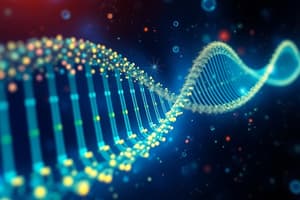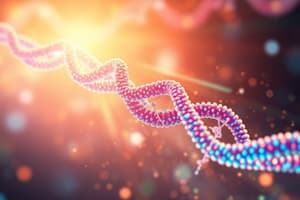Podcast
Questions and Answers
The identity percentage of the sequences compared is 86%.
The identity percentage of the sequences compared is 86%.
True (A)
BLASTn is primarily used for protein sequence analysis.
BLASTn is primarily used for protein sequence analysis.
False (B)
The score of the alignment is recorded as 272 bits.
The score of the alignment is recorded as 272 bits.
True (A)
The program TBLASTn compares protein sequences to translated nucleotide databases.
The program TBLASTn compares protein sequences to translated nucleotide databases.
In the alignment, there are more gaps in the query than in the subject.
In the alignment, there are more gaps in the query than in the subject.
The initialization matrix in the alignment process starts with a value of -6 in the top left corner.
The initialization matrix in the alignment process starts with a value of -6 in the top left corner.
The time complexity for the bounded-space computation of the algorithm is O(k*m), where k represents the radius explored.
The time complexity for the bounded-space computation of the algorithm is O(k*m), where k represents the radius explored.
In the update rule, the maximum scoring can only be computed using values from the left and top cells.
In the update rule, the maximum scoring can only be computed using values from the left and top cells.
A local alignment is defined as aligning entire strings s and t.
A local alignment is defined as aligning entire strings s and t.
The theoretical interest in the linear-space computation is related to its slower effective running time but guarantees the optimal answer.
The theoretical interest in the linear-space computation is related to its slower effective running time but guarantees the optimal answer.
The termination point for the alignment process occurs in the top left corner of the matrix.
The termination point for the alignment process occurs in the top left corner of the matrix.
The assertion that the heuristic utilized in the local alignment is always guaranteed to yield the optimal answer is incorrect.
The assertion that the heuristic utilized in the local alignment is always guaranteed to yield the optimal answer is incorrect.
The BLOSUM matrix begins with a GAP value of -3.
The BLOSUM matrix begins with a GAP value of -3.
In the PSSM construction, the logarithm used for conversion is typically to base 10.
In the PSSM construction, the logarithm used for conversion is typically to base 10.
If the scores for residues C and W in the matrix are equal, then C and W are not interchangeable.
If the scores for residues C and W in the matrix are equal, then C and W are not interchangeable.
The values in a Position-Specific Scoring Matrix represent raw frequencies of amino acids.
The values in a Position-Specific Scoring Matrix represent raw frequencies of amino acids.
A negative score in a PSSM indicates a nonconserved sequence match.
A negative score in a PSSM indicates a nonconserved sequence match.
Construction of a PSSM starts by calculating positional frequencies for a single nucleotide.
Construction of a PSSM starts by calculating positional frequencies for a single nucleotide.
The log odds scores in a PSSM are dependent on both alignment length and composition.
The log odds scores in a PSSM are dependent on both alignment length and composition.
The maximum score function max(-12, -8, 3) returns -8.
The maximum score function max(-12, -8, 3) returns -8.
Normalization in PSSM construction involves dividing positional frequencies by overall frequencies.
Normalization in PSSM construction involves dividing positional frequencies by overall frequencies.
The PSSM is exclusively used for protein sequences.
The PSSM is exclusively used for protein sequences.
The PAM matrix is based solely on the frequency of amino acid replacements in closely related proteins.
The PAM matrix is based solely on the frequency of amino acid replacements in closely related proteins.
BLOSUM scores are based on the expected mutation frequencies in protein families.
BLOSUM scores are based on the expected mutation frequencies in protein families.
Higher BLOSUM numbers indicate larger evolutionary distances between proteins.
Higher BLOSUM numbers indicate larger evolutionary distances between proteins.
The PAM250 matrix is used for aligning sequences that are 250% diverged.
The PAM250 matrix is used for aligning sequences that are 250% diverged.
Transversions are common and incur a lower penalty than transitions in nucleotide substitutions.
Transversions are common and incur a lower penalty than transitions in nucleotide substitutions.
The BLOSUM50 scoring system is derived from proteins with 50% overall identity.
The BLOSUM50 scoring system is derived from proteins with 50% overall identity.
The PAM1 matrix serves as a basic reference for substitution probabilities.
The PAM1 matrix serves as a basic reference for substitution probabilities.
BLOSUM matrices are primarily designed for nucleic acid sequence comparisons.
BLOSUM matrices are primarily designed for nucleic acid sequence comparisons.
In the context of amino acid sequences, a score of +1 indicates a strong similarity.
In the context of amino acid sequences, a score of +1 indicates a strong similarity.
The calculation of the sequence AACTCG fitting into the PSSM produced is finalized with the answer of 0.2.
The calculation of the sequence AACTCG fitting into the PSSM produced is finalized with the answer of 0.2.
In sequence alignment, the goal is to achieve an exact alignment between the new and previous sequences.
In sequence alignment, the goal is to achieve an exact alignment between the new and previous sequences.
The term 'indels' refers to insertions and deletions in the context of evolutionary events.
The term 'indels' refers to insertions and deletions in the context of evolutionary events.
The query of a new sequence must be very slow in order to analyze many unrelated sequences effectively.
The query of a new sequence must be very slow in order to analyze many unrelated sequences effectively.
The heuristic method BLAST is solely focused on local alignments without considering any evolutionary information.
The heuristic method BLAST is solely focused on local alignments without considering any evolutionary information.
The minimum number of transformation operations is critical for evaluating how sequences are aligned during global alignment.
The minimum number of transformation operations is critical for evaluating how sequences are aligned during global alignment.
The output of sequence alignments is required to be perfectly aligned with no mismatches to be relevant.
The output of sequence alignments is required to be perfectly aligned with no mismatches to be relevant.
The value of 6 divided by 30 equals 0.23.
The value of 6 divided by 30 equals 0.23.
Increased sequence availability leads to fewer problems in sequence alignment and analysis.
Increased sequence availability leads to fewer problems in sequence alignment and analysis.
Finding relationships among sequences only requires perfect matches to be useful.
Finding relationships among sequences only requires perfect matches to be useful.
Flashcards
String
String
A sequence of characters, often used to represent text.
Local Alignment
Local Alignment
A method for finding the best alignment between substrings of two sequences, maximizing the similarity between them.
Alignment Matrix
Alignment Matrix
A representation of the alignment score for each possible position in two sequences. It provides a visual representation of the similarity between the sequences.
Initialization of Local Alignment Matrix
Initialization of Local Alignment Matrix
Signup and view all the flashcards
Local Alignment Update Rule
Local Alignment Update Rule
Signup and view all the flashcards
Termination of Local Alignment
Termination of Local Alignment
Signup and view all the flashcards
Bounded-Space Computation
Bounded-Space Computation
Signup and view all the flashcards
Linear-Space Computation
Linear-Space Computation
Signup and view all the flashcards
PAM matrix
PAM matrix
Signup and view all the flashcards
BLOSUM matrix
BLOSUM matrix
Signup and view all the flashcards
Scoring matrix generation
Scoring matrix generation
Signup and view all the flashcards
Transition
Transition
Signup and view all the flashcards
Transversion
Transversion
Signup and view all the flashcards
PAM1
PAM1
Signup and view all the flashcards
PAM40, PAM250
PAM40, PAM250
Signup and view all the flashcards
Sequence Alignment
Sequence Alignment
Signup and view all the flashcards
Sequence Identity
Sequence Identity
Signup and view all the flashcards
What is a string?
What is a string?
Signup and view all the flashcards
Define 'Local Alignment'
Define 'Local Alignment'
Signup and view all the flashcards
What is an alignment matrix?
What is an alignment matrix?
Signup and view all the flashcards
How is a local alignment matrix initialized?
How is a local alignment matrix initialized?
Signup and view all the flashcards
What is the local alignment update rule?
What is the local alignment update rule?
Signup and view all the flashcards
Dynamic Programming
Dynamic Programming
Signup and view all the flashcards
Alignment Matrix Initialization
Alignment Matrix Initialization
Signup and view all the flashcards
Alignment Matrix Update Rule
Alignment Matrix Update Rule
Signup and view all the flashcards
Alignment Matrix Termination
Alignment Matrix Termination
Signup and view all the flashcards
Sequence Database
Sequence Database
Signup and view all the flashcards
Position-Specific Scoring Matrix (PSSM)
Position-Specific Scoring Matrix (PSSM)
Signup and view all the flashcards
Log Odds Score
Log Odds Score
Signup and view all the flashcards
Frequency Normalization
Frequency Normalization
Signup and view all the flashcards
Log Transformation
Log Transformation
Signup and view all the flashcards
Gap Penalty
Gap Penalty
Signup and view all the flashcards
Raw Frequencies
Raw Frequencies
Signup and view all the flashcards
Frequency Normalization
Frequency Normalization
Signup and view all the flashcards
Log Transformation
Log Transformation
Signup and view all the flashcards
Gap Penalty
Gap Penalty
Signup and view all the flashcards
Study Notes
Bioinformatics Overview
- Bioinformatics uses computational methods to analyze biological data.
- It involves computational biology, data analysis, and more.
- Key areas of study include sequence analysis, multiple sequence alignments (PSI-BLAST, Clustal-W), and genome annotation (HMM).
Sequence Analysis
- Methods for global and local sequence alignment are important (Needleman-Wunsch, Smith-Waterman).
- Penalty functions and substitution matrices play a crucial role in defining alignments.
- Heuristic methods like BLAST (Basic Local Alignment Search Tool) are used for faster sequence analysis.
- Genome annotation using Hidden Markov Models (HMMs) also plays a role.
Goals of the Module
- Understanding sequence analysis methods: global and local alignments, penalty functions, and substitution matrices
- Learning heuristic methods for sequence analysis (BLAST)
- Understanding multiple sequence alignments (PSI-BLAST, Clustal-W)
- Mastering genome annotation using HMMs
Challenges in Computational Biology
- Genome Assembly: Reconstructing the complete genome sequence from fragmented data.
- Gene Finding: Determining the location and boundaries of genes within a genome.
- Sequence Alignment: Comparing and aligning sequences to identify similarities and differences
- Database Lookup: Searching databases for similar sequences or structures.
- Comparative Genomics: Studying the evolution and relationships between genomes
- Evolutionary Theory: Using evolutionary relationships to provide insight into structure and function
- Gene Expression Analysis: Studying the activity of genes and their interactions.
- RNA transcript: Analyzing RNA information for gene expression
- Cluster Discovery: Grouping similar sequences or data points.
- Gibbs Sampling: Used to analyze and sample from probability distributions.
- Protein network analysis: Examining interactions between proteins
- Regulatory network inference: Identifying relationships between genes and gene regulatory factors
- Emerging Network properties: Understanding properties of complex biological networks.
Evolution of Functional Elements
- Evolutionary analysis reveals preserved functional elements.
- Specific examples of sequences and their functional elements
- Tools like those developed by Kellis et al. (Nature 2003) are used in the analysis of conserved sequences.
Gene Alignment
- Methods for aligning genes are critical for understanding evolutionary relationships and gene function.
- Aligning sequences involves identifying similarities and differences between the sequences.
- This process is often guided by established biological principles (e.g., mutations, deletions, insertions).
Genomes Change Over Time
- Mutations (changes in single nucleotide).
- Deletions.
- Insertions.
Goal of Alignment
- Determining the sequence variations (edit operations) between two sequences.
Formalizing the Problem
- Defining operations (insertion, deletion, mutation).
- Establishing optimality measures: minimum number of edits or minimum cost .
- Designing applicable algorithms
Dotplots in Bioinformatics
- Dotplots are visual tools for identifying sequence similarities.
- Two sequences are plotted on a grid.
- Diagonal lines in the dotplot indicate regions of similarity.
- Different types (e.g., perfect match, repeats, etc.)
Formulations of String Similarity
- Longest Common Substring: Finding the longest contiguous matching sequence in two strings (no gaps).
- Longest Common Subsequence: Finding the longest matching sequence in two strings (gaps are allowed).
Sequence Alignment
- Varying gap penalties (linear, affine) affect how gaps are treated in sequence alignments.
- Gap penalties are important to account for the varying costs of insertions and deletions in a sequence.
- This variation from uniform penalties to varying costs accounts for actual genome variation.
Substitution Matrices
- PAM (Percent Accepted Mutations) substitution matrices.
- BLOSUM (BLOcks SUbstitution Matrix) substitution matrices.
- Different matrices are needed to account for the different evolutionary relationships between sequences
Scoring Matrices
- Aligned sequences are rated based on the sum of positional scores from a matrix
- They derive from the observed mutations and similarities between amino acids sequences.
Position-Specific Scoring Matrices (PSSMs)
- Position-specific scoring matrices (PSSMs) contain the probability of amino acid (or nucleotide) occurrence at each position of a multiple sequence alignment
- Calculating and using PSSM involves defining a method for assigning scores
- A specific method of determining the scores is to calculate the log-odds
- These calculated values are used in calculations to see how a particular amino acid or nucleotide fits into the matrix
Heuristic Methods
- BLAST is a heuristic method, which means it uses approximations to produce results relatively quickly
- It does so by searching databases for sequences with significant similarity to a query sequence (the unknown)
- BLAST allows for faster database searches compared to global alignment
BLAST Algorithm
- This is a two-step heuristic algorithm:
- Identifying potentially significant regions (words) within the query sequence.
- Identifying alignments within the word list to those in the database.
Multiple Sequence Alignments (MSAs)
- Methods for comparing multiple sequences simultaneously
- Tools like ClustalW use progressive alignment that builds on phylogenetic trees
- The goal is to identify regions of conservation.
Annotation of Genomes
- Identifying coding regions and functional elements of genomes.
- Methods often are based on Hidden Markov models (HMMs).
Eukaryotic Gene Structure Features
- Exon structure and functions in eukaryotes
- The elements and role of start codons (ATG sequence)
- The elements and function of stop codons (TAG/TGA/TAA)
- Role of splice sites
- The general structure of a eukaryotic gene
Gene Prediction
- Predicting coding regions from genome sequences.
- Methods are based on characteristics of coding segments such as specific nucleotide sequence patterns, such as start and stop codons, or characteristic length changes. (HMMs).
Content Regions
- Features of the sequences in coding regions
- Nucleotide order and how they relate to gene function
- Probability of certain hexanucleotides found in coding sequences
Generalized HMMs (GHMMs)
- GHMMs are complex HMMs that extend the simple concept of HMMs by explicitly modeling the variable lengths of relevant sequence features
- These can be used to define and predict segments within genetic sequences such as coding or non-coding regions
Training Models
- Obtaining training data from a gene set in an organism
- Using the gene set to develop a statistical model (HMM or GHMM model) for finding other genes
- Validating the model through evaluation
Gene Prediction Accuracy
- Measuring the performance of a gene finder
- Quantifying how effectively a method identifies genes
- Using true/false positives and negatives in calculations of accuracy rates
Studying That Suits You
Use AI to generate personalized quizzes and flashcards to suit your learning preferences.




